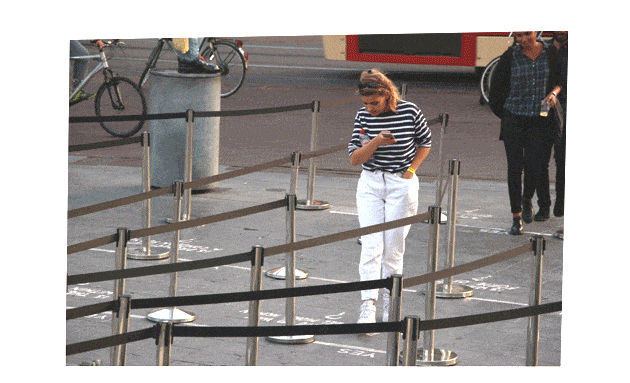THE POLITICS OF QUEUING
AND THE ARCHITECTURE
OF THE QUEUE
Urban intervention
The Politics of Queuing and the Architecture of the Queue deals with the spatial, mental, political, economic and social implications of the queue, its taxonomies, preconditions, procedures and the parameters of interdependence between its actors, and it will manifest in a digital research database and in physical interactions with queues.
As diverse as the contexts in which queues might take place and as different they might be in shape, there is one aspect unifying (almost) all of them: the act of waiting implies by definition a clear separation and relation of power between the one waiting and the one able to make the waiting end. Queues are always directional – an directed. A queue can be influenced through psychological manipulation but also physically: by specific elements and by spatial means. At the same time it represents equality – as everyone has their place irrespectively of social status, class, gender, or ethnicity. The reason for queuing – no matter under which terms it happens – is the same for everybody and social differentiation appears rather arbitrary.
The queue presents a metaphor for the ambivalence of the Western notion of public space as we encounter it today, and reveals potential forces for its possible conversion. Standing in queues bears the spatial and mental implication of a threshold situation, a physical space of ‘in between’ and in flux, a place of negotiation and for developing agency. We aim to ‘make use’ of the queue’s heterotopic qualities, and explore it as a potential means to foster human agency within a more and more contested urban environment.
PROTOCOL #1
TODAYSART FESTIVAL
People line up in railway stations, shops, border controls, museums. Queues are an increasingly dominant spatial phenomenon that presents us with a powerful metaphor for the ambivalence of the Western notion of public space as we encounter it today.
The queue as such is used as a managerial tool to control individual bodies, spaces and publics, but at the same time, it represents equality. While queuing, social differentiation appears rather arbitrary. Queues bear the spatial and mental condition of being nor inside nor outside: while queuing you are nowhere, in between, on a threshold, in constant flux. We experiment with collective dynamics and movements to raise questions about the democratic qualities of public space and the agency of the ‘public’. Through a series of four public interventions, each deploying a set of rules, layouts, and instruments, their project we explore both the spatiality of queuing systems and the experience of queuing itself.
EXTERNAL LINKS +
TodaysArt 2016
Future Architecture Platform
SOCIALS +
CONTACT US +
For more information, please write an email to hallomarginal@gmail.com













